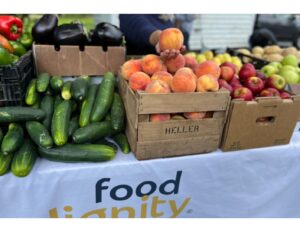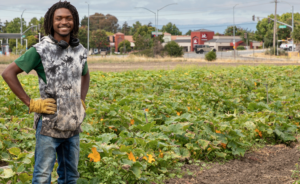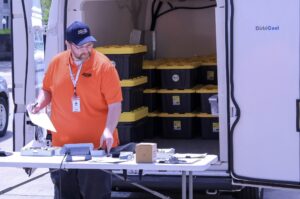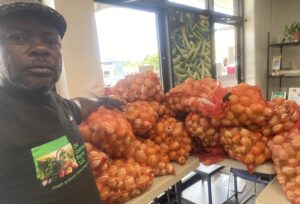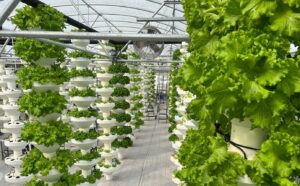There are lots of reasons for food banks to have farms, and most of them don’t have to do primarily with distributing food.
That’s the case at Mid-Ohio Food Collective, which is building a farm of the future consisting of high-tech growing spaces and learning facilities. Spanning seven acres in the city of Columbus, the “smart farm” supports MOFC’s overall approach to combating hunger through food provision, education and conservation.
MOFC’s Hilltop farm stands out as a showcase for advanced agricultural techniques like vertical growth towers, hydroponics, container farming, fabric gardening systems, and even farm robots. Given the focus on innovation, the amount of actual food produced is almost besides the point. At the heart of it, the farm wants to be as close to the forefront of scientific research and agricultural innovations as possible, and share that knowledge throughout the community.
“We try to think about the output being the learning, [which] is the primary. The poundage is probably the subordinate to that,” said Nick Davis, Chief Innovation Officer.
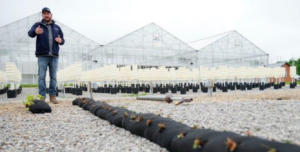
MOFC had tried traditional in-ground techniques at a few different locations when Davis joined the organization in 2019. Despite the dedication of volunteers, the team struggled to get consistent yields. Soon, the idea of developing a high-tech farm with an educational purpose emerged, as it would allow greater control over processes, offset the adverse impact of climate change, optimize the volunteer experience, and empower community members.
“Not only can we provide food from a yield perspective, but also teach folks the practices to make them self-sufficient when it comes to growing,” said Trevor Horn, MOFC’s Farm Director.
The educational smart farm has been years in the making. Significant support has come from the city, which subsidized the farm through a multi-year lease, in addition to providing $4.5 million through a federal Community Development Block Grant. Other sources of funding have come from the USDA, local corporations, foundations and individuals. “Public-private partnerships are certainly the biggest thing that’s been an extremely valuable asset and supportive of this project,” Davis said.
The smart farm is the newer and larger of two MOFC farm locations. Compared to a more traditional farm located behind an NBC television studio, Hilltop farm is more than double in size, though currently is operating at 20 percent of its expected full capacity. In June, the farms together produced 2,100 pounds of fresh produce.
When it came to finding a farm director, Davis said he had a choice of hiring “a farmer who can teach a little, or hire a teacher who can do farming.” He chose the latter. “That for us was a very intentional choice.” Davis said that Horn, an educator with a culinary background, understands how to engage kids and communicate the value of the farm’s unconventional methods, as well as their significance to the environment. “And then, he can obviously geek out with them a little bit about, you know, soil health and soil nutrients,” Davis said.

There is innovation aplenty throughout the farm. In the open field, there are 300 Verti-Gro towers with five pots in each tower, allowing 25 plants to grow in a single square foot, according to Horn. A shipping container farm provides a tightly controlled environment to grow lettuces, radishes and herbs, which have been popular with clients of Mid-Ohio Market where the harvest usually goes. “The nutritional density is very apparent,” said Horn. Further aspirations include continued work on controlled-environment greenhouses and high tunnels; drones with geo-thermal detectors and cameras; solar panels; artificial intelligence tools and more.
Various robots use sensors, motors and cameras to seed and support the growth of new plants. A growing container similarly uses software, sensors and lighting to maximize growth, while minimizing the need for anyone to be on site. People can log in with a mobile app to see current conditions and make changes as needed.
The architecture of the farm is geared toward community engagement. A large multi-purpose building with an open layout, which Horn calls a “blank canvas,” is designed for educational and kitchen demonstrations, workshops, and community gatherings. A workforce development area hosts workshops for high school and post-high school students. “There’s so much that’s coming into the agriculture world,” Horn said. “So we’re looking to connect those opportunities for the students.”
Part of the rationale for practicing non-soil-based farming is practical. Located in highly developed city land, the farm’s soil health is too disrupted to be used in growing, and regenerating it would take seven to ten years. The farm plans to move slowly into in-ground soil-based farming, partly by continuing with Garden Soxx, a growing system that works by wrapping soil and plant roots in fabric containers.
People in the neighborhood have shown pride about the space and its connection to a neighborhood conventionally considered “rough.” Davis said the farm can help people envision the future of urban agriculture while also developing a local workforce and the leaders needed for it.
“The future is here,” Davis said. “If we don’t start solving the problem differently, we believe that unfortunately, the need is going to outpace our ability to be able to serve it in the future.” – Kathy Ou
Kathy Ou is a reporter and critic based in New York, bred in Southern California and born in Southern China. She is a student at New York University’s Cultural Reporting and Criticism program. Her writings have appeared on Prism, AsAmNews, The Yappie, The Amp and more.
CAPTION, TOP: Last month, Mid-Ohio Food Collective hosted BIPOC farmers and growers, along with USDA representatives, at its high-tech Hilltop farm.
Like what you’re reading?
Support Food Bank News

